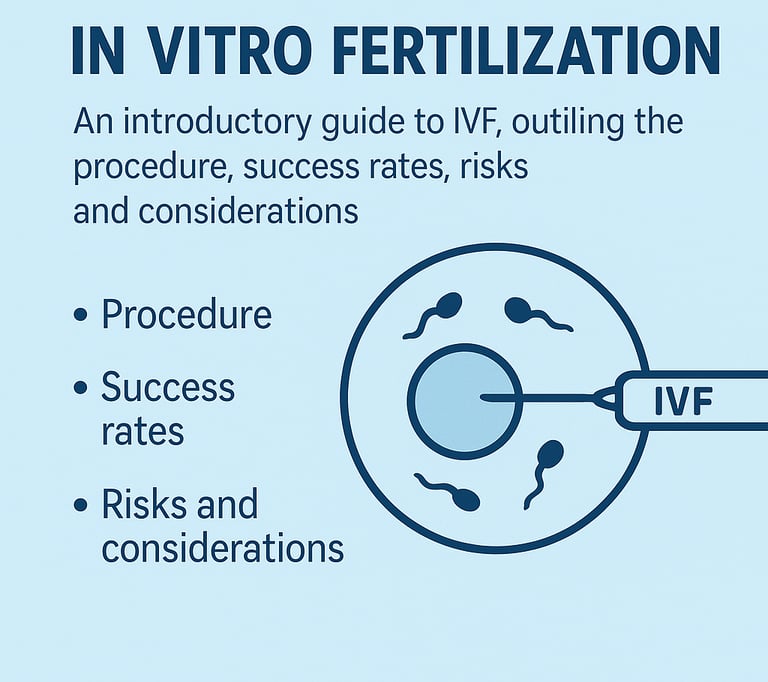Stay updated on what is trending in health. Discover tips and resources for a healthier, balanced life.
What Is IVF and What Happens During the Process?
Discover how IVF (In Vitro Fertilization) helps couples overcome infertility by fertilizing eggs outside the body and implanting embryos for a healthy pregnancy. Learn about the process, benefits, and options available.
WELLNESS
Dr. S. Ali
7/9/20256 min read


In recent decades, medical science has opened up new possibilities for people who struggle to have children. One of the most well-known fertility treatments today is IVF, short for in vitro fertilization. You may have heard of it, especially in conversations about infertility or assisted reproduction, but many people are unsure what it actually involves.
Whether you're exploring IVF for yourself or just want to understand it better, this article will walk you through what IVF is, why it's used, and what really happens step by step during the process.
What Is IVF?
IVF stands for in vitro fertilization, which literally means “fertilization in glass.” It’s a process where an egg is fertilized by sperm outside the body—in a lab—and then the resulting embryo is placed into the uterus to grow naturally.
In IVF, mature eggs are collected from the ovaries after hormone stimulation and combined with sperm in a lab dish to allow fertilization outside the body. Once an egg is fertilized and develops into an embryo over a few days, the healthiest one is selected and transferred into the uterus using a thin catheter. If the embryo implants successfully in the uterine lining, pregnancy occurs. This is the process often referred to as having a "test-tube baby," though the term is outdated—only fertilization happens in the lab; the baby grows naturally in the womb like any other pregnancy.
IVF is one of the most widely used forms of assisted reproductive technology (ART) and is often recommended when other fertility treatments have failed. It gives couples a chance to conceive using their own or donor reproductive cells.
Who Might Need IVF?
IVF is recommended in a variety of situations, including:
Women with blocked or damaged fallopian tubes
Men with low sperm count or poor sperm motility
Couples who haven’t been able to conceive after trying for a year or more (unexplained infertility)
Women with ovulation disorders like polycystic ovary syndrome (PCOS)
People using donor eggs or sperm
Women with endometriosis
People using a gestational carrier or surrogate
It’s also an important option for preserving fertility in individuals who are about to undergo cancer treatment, such as chemotherapy or radiation, which can damage the ovaries or testicles and affect future fertility. In these cases, eggs, sperm, or embryos can be collected and frozen (a process known as cryopreservation) before treatment begins. This allows people the possibility of having biological children later, once their health is stable and they’re ready to start a family.
What Happens During IVF?
IVF involves several carefully timed steps. It’s not a quick fix—it usually takes several weeks per cycle and may require more than one attempt. Here’s how it typically works:
1. Ovarian Stimulation
The first step involves stimulating the ovaries with hormone medications. Normally, a woman’s ovaries release one egg per cycle. With IVF, the goal is to mature multiple eggs to increase the chances of successful fertilization.
You’ll take fertility injections for about 8 to 14 days. Your doctor will monitor you closely using blood tests and ultrasounds to track how your follicles (which contain the eggs) are developing.
2. Egg Retrieval
Once the eggs are ready, they’re retrieved in a minor outpatient procedure called follicular aspiration. This is usually done under light sedation or anesthesia.
A thin needle is guided into the ovaries using ultrasound imaging, and the eggs are gently suctioned out. The procedure takes about 20 to 30 minutes, and you can usually go home the same day.
3. Sperm Collection
On the same day as egg retrieval, a sperm sample is collected from the male partner or sperm donor. If needed, sperm may be retrieved surgically, especially in cases of low sperm count or blockages.
The best sperm are selected in the lab for fertilization.
4. Fertilization and Embryo Development
In the lab, the retrieved eggs are combined with sperm. This can be done in two ways:
Conventional IVF, where sperm and eggs are mixed together and left to fertilize naturally
ICSI (intracytoplasmic sperm injection), where a single sperm is injected directly into an egg, often used for male infertility
Once fertilization occurs, the embryos are cultured in a special incubator for about 3 to 5 days. The embryologists monitor them carefully to assess their development and quality.
5. Embryo Transfer
When the embryos reach the right stage—usually the blastocyst stage on day 5—one or more are selected for transfer into the uterus.
The transfer is a simple, painless procedure that doesn’t require anesthesia. A thin catheter is used to place the embryo directly into the uterine cavity. The whole process takes just a few minutes.
Any remaining healthy embryos can be frozen (cryopreserved) for future use.
6. The Two-Week Wait and Pregnancy Test
After the embryo transfer, you’ll enter what many call the “two-week wait.” During this time, you’ll take it easy and follow your clinic’s guidance while waiting to take a blood test that checks for pregnancy.
If the embryo implants successfully into the uterine lining, pregnancy will be confirmed by rising levels of hCG (human chorionic gonadotropin), the pregnancy hormone.
What If the First Cycle Doesn’t Work?
It’s important to know that not all IVF cycles result in pregnancy. Success depends on many factors, including the woman’s age, the reason for infertility, egg and sperm quality, and the number of embryos transferred.
Sometimes, several cycles are needed. Frozen embryos from the first cycle may be used in future attempts, which makes subsequent cycles shorter and less intensive.
What Are the Success Rates of IVF?
Success rates vary depending on age and individual circumstances. According to most fertility centers:
Women under 35 have a 40–50% chance of live birth per IVF cycle
Women between 35–37 have about a 30–40% success rate
Women 38–40 may see rates around 20–25%
After age 40, success rates drop significantly
Using donor eggs can improve outcomes for older women.
Are There Risks With IVF?
IVF is generally safe, but like any medical procedure, it carries some risks. These include:
Ovarian hyperstimulation syndrome (OHSS), a reaction to fertility drugs that can cause swollen, painful ovaries
Multiple pregnancy if more than one embryo is transferred
Ectopic pregnancy, where the embryo implants outside the uterus
Emotional stress and financial strain, especially if multiple cycles are needed
Your fertility specialist will talk to you about these risks and how they are managed.
How Much Does IVF Cost?
The cost of IVF depends on the country, clinic, and whether you’re using additional services like ICSI, embryo freezing, or donor eggs or sperm. On average, IVF can cost several thousand dollars or more per cycle. Some countries offer partial insurance coverage or public assistance, while others require out-of-pocket payment.
It's a good idea to ask your clinic for a detailed breakdown of all expected costs.
Is IVF Right for You?
Choosing IVF is a personal decision that depends on your health, age, fertility diagnosis, and emotional readiness. It can be a physically and emotionally intense journey, but for many people, it offers the best chance of building a family.
If you’re considering IVF, talk to a fertility specialist who can guide you through testing, timing, and treatment options tailored to your situation.
Alternatives to IVF
There are several alternatives to IVF, depending on the cause of infertility, the couple’s health, and personal preferences. Here are the most common ones:
1. Ovulation Induction (OI)
This is often the first step in treating infertility, especially in women who have irregular or absent ovulation. Fertility medications like clomiphene citrate or letrozole stimulate the ovaries to release eggs. It can be combined with timed intercourse or intrauterine insemination (IUI).
2. Intrauterine Insemination (IUI)
In IUI, sperm is collected, washed, and then inserted directly into the uterus around the time of ovulation. This increases the chances of fertilization by bringing sperm closer to the egg. It’s less invasive and less expensive than IVF, and is often used for mild male infertility, unexplained infertility, or cervical mucus problems.
3. Fertility Surgery
Surgery may be recommended if there are physical issues preventing pregnancy, such as blocked fallopian tubes, uterine fibroids, endometriosis, or adhesions. Correcting these conditions can sometimes restore natural fertility.
4. Lifestyle Changes
For couples dealing with mild infertility, simple changes—like weight management, quitting smoking, reducing alcohol, improving diet, and managing stress—can sometimes restore fertility without the need for advanced treatments.
5. Donor Eggs, Sperm, or Embryos
If one partner has fertility issues that can’t be treated, using donor eggs, sperm, or embryos is another option. These can be used with IVF or, in some cases, IUI (intrauterine insemination).
6. Surrogacy or Gestational Carriers
When a woman is unable to carry a pregnancy due to medical reasons, another woman (a surrogate or gestational carrier) can carry the baby. This is usually done through IVF using the intended parents’ or donors’ reproductive cells.
7. Adoption
Although not a medical alternative, some couples or individuals choose to build their families through adoption when other methods have not been successful or are not preferred.
Final Thoughts
IVF is not a guarantee, but it offers hope to millions of people who would otherwise be unable to conceive. Understanding the steps involved can help you feel more informed and in control during what can be a challenging process.
Whether you’re just beginning to explore fertility treatment or you’re already planning your first cycle, knowing what to expect is an important part of the journey.
Sources:
American Society for Reproductive Medicine (ASRM)
https://www.asrm.org/topics/topics-index/in-vitro-fertilization-ivf/
Mayo Clinic – IVF Overview
https://www.mayoclinic.org/tests-procedures/in-vitro-fertilization/about/pac-20384716
Centers for Disease Control and Prevention (CDC) – Assisted Reproductive Technology (ART)
https://www.cdc.gov/art/
National Health Service (NHS) – IVF Treatment
https://www.nhs.uk/conditions/ivf/
Fertility Network UK
https://fertilitynetworkuk.org/ivf-explained/
The British Fertility Society
https://www.britishfertilitysociety.org.uk/
World Health Organization (WHO) – Infertility and Reproductive Health
https://www.who.int/reproductivehealth/topics/infertility/en/
Pulse Your Health
Empowering you to achieve your health goals.
Contact
© 2025. All rights reserved.
Disclaimer: The content on this website is for informational purposes only and is not medical advice. Always seek the advice of your physician or other suitably qualified healthcare professional for diagnosis, treatment and your health related needs.
